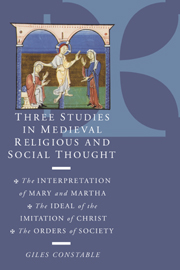 Three Studies in Medieval Religious and Social Thought
Three Studies in Medieval Religious and Social Thought Book contents
- Frontmatter
- Contents
- List of illustrations
- Preface
- List of abbreviations
- I THE INTERPRETATION OF MARY AND MARTHA
- II THE IDEAL OF THE IMITATION OF CHRIST
- III THE ORDERS OF SOCIETY
- Introduction
- The early Middle Ages
- The eleventh and twelfth centuries
- From the twelfth century to the end of the Middle Ages
- Appendix: mediocres (mediani, medii) in the Middle Ages
- Bibliography of secondary works
- Index of manuscripts
- Biblical index
- General index
From the twelfth century to the end of the Middle Ages
Published online by Cambridge University Press: 08 December 2009
- Frontmatter
- Contents
- List of illustrations
- Preface
- List of abbreviations
- I THE INTERPRETATION OF MARY AND MARTHA
- II THE IDEAL OF THE IMITATION OF CHRIST
- III THE ORDERS OF SOCIETY
- Introduction
- The early Middle Ages
- The eleventh and twelfth centuries
- From the twelfth century to the end of the Middle Ages
- Appendix: mediocres (mediani, medii) in the Middle Ages
- Bibliography of secondary works
- Index of manuscripts
- Biblical index
- General index
Summary
from the point of view of late medieval social thought, the two most significant developments in the ordering of society in the eleventh and twelfth centuries were, first, the recognition of the growing number of professional and occupational groups, and of the differences between them, and, second, the acceptance of the independence, and rise in status and prestige, of the order of bellatores or milites. These two developments will be studied in this final section, but attention will also be given to the continuing importance of the old bipartite and tripartite divisions of society.
A third element, which was of more importance for social thought generally than specifically for the concept of orders, was the articulation and elaboration of models of society based on social units like towns and households, on ships and armies, and above all on the human body, which emphasized the functional interrelation of different groups in society. Each of these had ancient roots. The idea of the city and city-state as a paradigm of society generally went back to Antiquity and had many exponents in the Middle Ages, especially after the revival of interest in Plato's Timaeus and other classical texts. The comparison of society to a well-ordered army can be seen in the use made by many writers, such as Henry of Marcy in the passage cited at the end of the previous section, of the image of the ‘army set in array’ from the Song of Songs 6.3. Even more important was the idea of society as a body, of which the parts corresponded to the various groups in society.
- Type
- Chapter
- Information
- Three Studies in Medieval Religious and Social ThoughtThe Interpretation of Mary and Martha, the Ideal of the Imitation of Christ, the Orders of Society, pp. 324 - 341Publisher: Cambridge University PressPrint publication year: 1995


